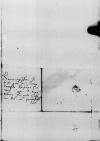List #2029
Mikołaj MYSZKOWSKI do Ioannes DANTISCUSKuringen, 1532-01-02
Rękopiśmienne podstawy źródłowe:
| ||||
Tekst + aparat krytyczny + komentarzZwykły tekstTekst + komentarzTekst + aparat krytyczny
Reverendissimo in Cristo patri et domino
Reverendissime Domine mihi gratiosissime.
Vestram Reverendissimam Dominationem in multos annos sanam et incolumem esse cupio.
Dominus meus reverendissimus
Datum
Nicolaus Myszkowszky servitor Vestrae Reverendissimae Dominationis


 BK 230, p. 74
BK 230, p. 74